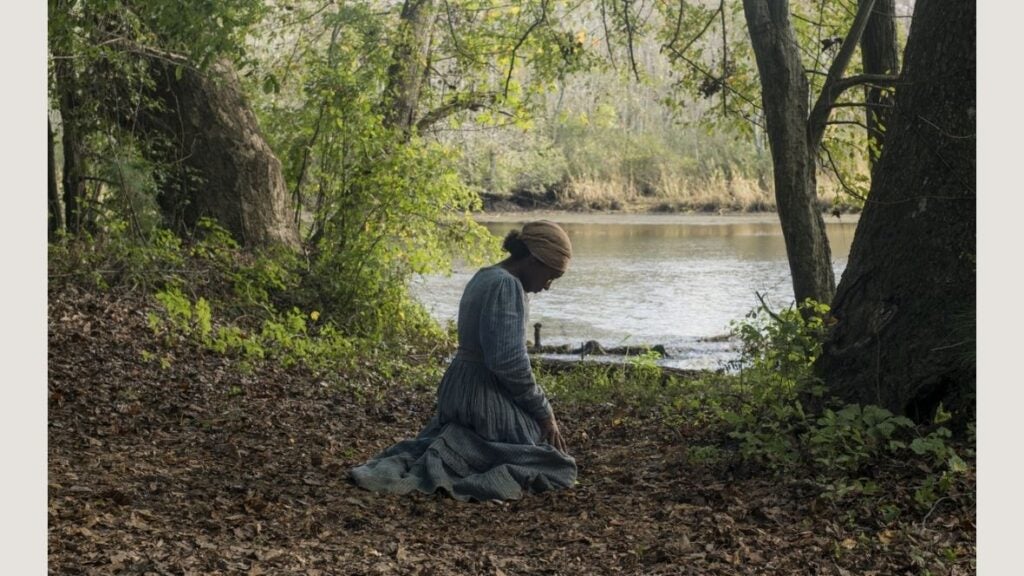“God Don’t Mean People to Own People”

History has traditionally been told by the victors, and white male film directorship has reflected this trend. Films like Mississippi Burning (1988), Green Book (2018), The Butler (2013), and Hidden Figures (2016) have attempted to tell African American stories but their white directors have limited their ability to portray an authentic perspective. A handful of high-profile historical films by African American directors have gotten closer, such as Malcolm X (Spike Lee), Fruitvale Station (Ryan Coogler), and Selma (Ava DuVernay).
Harriet was released in 2019 on the 400th anniversary of the importation of slaves into the United States, amid the intersection of the Black Lives Matter (BLM), as the gendered #metoo movement swept Hollywood, and the nation debated replacing Andrew Jackson on the $20 bill with none other than Harriet Tubman. Black feminists drew on Kimberlé Crenshaw’s notion of intersectionality, which has figured centrally in third-wave feminism, to foreground the experiences of African American women in these debates. Director Kasi Lemmons captured the spirit of the moment, bringing welcome attention to a woman historical hero much overdue for her spotlight. Now, we have for the first time an African American woman director proudly highlighting the story of Harriet Tubman: an escaped African American woman who used her freedom to rescue others.
Harriet Tubman was a remarkable woman. She fled 100 miles from the Eastern Shore of Maryland to Philadelphia alone, only to turn around to help others escape slavery. Her perseverance shines when she returns on 13 trips to the South to rescue 70 slaves during the perilous time after the passage of the Fugitive Slave Act in 1850. Throughout the film, Harriet uses coded messages or hidden transcripts through slave songs to call out to slaves to leave the plantation: “wade in the water,” and “tell pharaoh to let my people go.” These words were familiar to slaves who know the story of Exodus when Moses led his people out of slavery in Egypt, which is how Harriet acquires her (masculine) nickname. Most people, black or white, could not imagine that the rumored “Moses” could be a woman, and these conversations are shown in scenes around Maryland.
On the journey to Philadelphia, we see the “underground railroad” exposed. Pastors hide runaways under floorboards, sailors ferry them over the waterways, a blacksmith drives them to the border, and free black people in the city offer advice to the new arrivals: to act like they belong there. The major characters who stand out in Philadelphia are William Still, the organizer of the Underground Railroad, and his (fictional) boarding house partner, Marie Buchanan. Marie helps Harriet to climatize to city life while William inducts her into the abolitionist circle as a conductor. We also see character cameos of other well-known participants of the abolitionist movement: John Brown of the fabled failed raid on the arsenal at Harper’s Ferry and Frederick Douglass with his distinguishable hairstyle at the home of Senator William Seward, who would become Secretary of State after his failed bid for the presidency and his famous “Higher Law” speech that cemented his place as an antislavery leader in the US Senate.
Director Kasi Lemmons focuses on the victories and liberation of freedom, rather than the pain and humiliation at the center of some other recent films depicting slavery, where torture, rape, and the inhumanity of the practice are shown more explicitly, such as Twelve Years a Slave (2013) or HBO’s series Roots (2016). Still, Lemmons alludes to Harriet’s traumatic past with blue-tinted flashback-vision scenes. Harriet uses these as a warning system when avoiding slave catchers. These “spells” in fact resulted from a childhood injury. Harriet was hit in the head when an overseer threw a weight intended for another slave that rendered her unconscious for several days and left her with hypersomnia or epileptic seizures for the rest of her life. But the film spins these to show how they drew Harriet closer to God so she could seek guidance in the escape. We see the brutality of slavery in other ways: in the scars on slaves’ backs, the trepidation they show towards whites and allusions to rape. The reductionist inhuman descriptions of slaves also sting the ears as Gideon describes them as bucks, females, and foals, and his mother Eliza defends herself by explaining, “Your stature in this community is measured in Negroes.” Other films also emphasize the importance of one’s name in relation to their identity, and Harriet’s choosing of her name based on her family heritage reiterates how she chose her new identity by gaining her freedom.
Lemmons distinguishes Harriet by emphasizing her willingness to meet violence with violence. She carries a pistol and brandishes it to pressure runaways whose courage fails them, for they would threaten her entire operation if caught. She shoots Gideon to prevent further violence, not to kill him. And the largest show of determination was her ability to lead 150 armed soldiers in the Combahee River Raid during the Civil War to free another 750 slaves. The film closes by sharing that Harriet worked towards civil rights until the end of her long 91-year life in the women’s suffrage movement, perfectly tying together the intersectionality of where the movement of the third wave currently stands. The movie certainly achieves its goal of inspiring others through this icon of courage and freedom.
References:
Simran Hans, “Harriet Review – Thrilling Drama about the Abolitionist Harriet Tubman,”
The Guardian, November 24, 2019,
https://www.theguardian.com/film/2019/nov/24/harriet-review-harriet-tubman-biopic-cynthia-erivo-janelle-monae
Kathleen Lawrence, “Review of Harriet,” The Journal of American History, Vol. 107, No. 1, 278–280, 06 June 2020, pages 808-815.
A.O. Scott, “‘Harriet’ Review: Becoming Moses,” New York Times, October 31, 2019, https://www.nytimes.com/2019/10/31/movies/harriet-review.html
Article by Brittany Bounds, Assistant Professor at Texas A&M University at Qatar